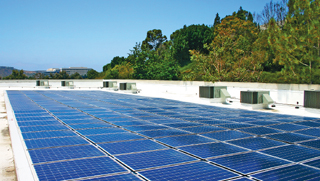
DJC.COM
April 24, 2008
Time to improve hospital energy standards
so why isn’t more expected of them?
X-nth

Hess
|

Tinkoff
|
Hospitals are here to help heal people — they should be here to help heal the environment, too.
Last year the United Nations Foundation issued a report, “Confronting Climate Change: Avoiding the Unmanageable and Managing the Unavoidable,” which presents a small window of opportunity to avoid unmanageable climate change due to our thirst for fossil fuel. It indicates that carbon dioxide emissions associated with burning fossil fuels must level off by 2015 to 2020 and then decline.
The building industry has responded with several initiatives: the 2030 Challenge, the U.S. Green Building Council’s LEED certification program and the Green Guide for Health Care.
The threat of unmanageable climate change and these associated initiatives raise two important questions: How well do these current green standards help us achieve carbon neutrality goals, and how feasible is it to meet these goals?
Both LEED and the Green Guide for Health Care utilize ASHRAE/IESNA 90.1-2004, an industry building-energy standard, to analyze energy efficiency of a building.
They specifically use the standard’s performance rating method, which requires at least two computer energy simulations to predict energy costs. One simulates the actual designed building, and the second, a “baseline” simulation, represents the energy of a current “code” building.
The difference between them is translated into LEED or Green Guide for Health Care certification points. But it is our opinion that ASHRAE/IESNA 90.1-2004 needs improvement when it comes to hospitals.
Carbon neutrality

Photo courtesy of X-nith While solar panels can add up to 22 percent to the cost of a project, the expense can be defrayed by state and federal incentives. |
The Green Guide for Health Care awards minimal points for renewable energy while LEED awards significantly larger points based on the building’s renewable energy percentage. The guide may want to analyze whether or not “sustainable” hospitals should be doing less than other building types when it comes to renewable energy. Perhaps hospitals should be taking the lead instead.
The real question is, how can a hospital reasonably achieve “carbon neutral” status? Typically, inpatient health care facilities annually use 21.5 kilowatt hours of electricity per square foot and 50.2 kilo British thermal units of fuel per square foot. X-nth has also benchmarked a few facilities and found the range to be between 15-40 kwh/sf based on facility age.
Hospitals are long-term investments and will operate for a minimum of 30-50 years, with some operating much longer. They are huge energy consumers and we have a duty to evaluate long-term operating costs versus initial construction costs.
Energy-saving options
Several potential options put energy-use and the carbon-neutrality goals into perspective.
Renewable energy credits: Currently inexpensive. X-nth recently purchased 100 percent green power (a mix of wind and biogas) for all its offices at only $0.0055 per kilowatt hour. At 21.5 kwh/sf per year and $0.0055 per kilowatt hour, the cost amounted to $0.12 per square foot per year.
For a 200,000-square-foot facility, that’s $24,000 in additional operating costs to make its electricity use carbon neutral via renewable energy credits. (For additional information about how renewable energy credits work, refer to green-e.org/dictionary.shtml#REC.)
Solar power (photovoltaics): Many places in the U.S. would need about 11 or 12 watts of solar photovoltaic panels to generate 21.5 kwh annually. The installed cost for these systems has been $8-$10 per watt.
With total project costs running $450-$1,400 per square foot, the photovoltaic premium could be 7 percent to 22 percent to make their electricity use carbon neutral via on-site energy production. These costs could be reduced by state and federal incentives. For example, Florida currently offers a rebate that pays nearly half the installed cost of solar power systems; California will pay 25 percent to 35 percent of the costs.
Biomass power plant: There are various forms of biomass power. Current technologies focus on high-cost feedstock to produce ethanol. But for on-site power production, emerging technologies like gasification of low-cost feedstock may be more suitable.
This would consist of biomass fields (such as wood or grass) and a pelletizer to convert the biomass into small pieces. The pellets would be fed into a gasifier to create a synthetic gas (syngas) that is similar to liquid petroleum but with lower energy content. The syngas could be used to operate an engine generator.
The gasification process releases carbon into the atmosphere. The carbon is removed from the atmosphere by the growing biomass. These two processes balance each other out so that gasification is a carbon-neutral process.
Biomass gasification can produce carbon-neutral electricity at a cost of approximately 14 cents per kilowatt hour. In comparison, the U.S. average commercial electric rate in 2006 was only 9.4 cents per kilowatt hour. This cost difference of 4.6 cents per kilowatt hour would increase a hospital’s operating cost by about $1 per square foot a year.
It is important to note that biomass costs should remain stable. Conversely, fossil-fuel electricity prices will likely continue to increase as resources diminish. The average commercial electric price in the U.S. has increased an average of 2.1 percent a year for the past 10 years. As fossil-fuel electricity costs continue to rise and biomass costs decrease or stabilize, the premium for biomass power may disappear.
Biomass power plants have an initial construction cost premium of $11 per square foot (generally less than 3.5 percent of construction cost) to provide 100 percent biomass electricity.
Solar hot water: An average health care facility uses 50.2 kBtus/sf of fuel per year, mainly for heating and water. A hospital would require about $12 per square foot in initial construction costs for solar hot-water panels and appurtenances to produce the required hot water.
The average commercial price for natural gas in 2006 was $1.20 per therm (100,000 Btu). Based on that rate, using solar hot water instead of natural gas could save about 60 cents per square foot annually. Over the last 10 years, the cost of natural gas has increased an average of 9.45 percent per year, rising more rapidly than electricity prices.
Help for health care
Current green and sustainable standards have done a great job of bringing terms like carbon neutral to the center of attention, but these standards need some work if they are truly going to help the health care market reach its carbon neutrality goals.
It is already possible to make a hospital carbon neutral, but there is a price tag that accompanies this title. The options listed show how it can be done while lowering operating costs.
If a facility can exceed the existing energy standards by a significant amount, there are federal tax deductions of up to $1.80 per square feet to offset this additional cost. This tax deduction is currently available through 2008, and Congress is working to extend it until 2013 and increase the deduction to $2.80 per square foot. A carbon-neutral hospital could also make additional income by selling its renewable energy and carbon credits.
Options like total energy recovery, variable air-volume systems, displacement ventilation and operable windows could yield significant energy savings and will have very good paybacks. These options are currently being used in parts of Europe and Asia, but many of these energy-efficiency features are limited by current health care standards, which should be revisited if the industry wants to take a serious step towards confronting climate change.
Mike Hess is a principal at X-nth and a mechanical engineer whose focus is on green and sustainable strategies. Ari Tinkoff, vice president, handles project management, production and coordination, and has been involved with nearly 2 million square feet of health care-based projects.
Other Stories:
- Boomers lifting standards for patient care
- Architects play key role on health care team
- How BIM helped a hospital go green
- Boomers influence next generation of senior housing
- Innovative structures help hospitals cut costs
- For patients, silence is golden
Copyright ©2009 Seattle Daily Journal and DJC.COM.
Comments? Questions? Contact us.